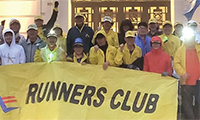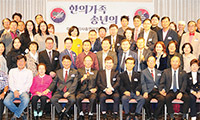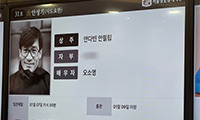An Obsession Evolves Into a Contemporary Art Museum
NEW DELHI - Anupam Poddar had a living room once.
These days the sofa is shoved into a corner, and the rest of the space is taken up by a life-size model of an antique creamcolored Jaguar with a giant mechanical dinosaur mounting it from behind. On the dining table sits a row of exquisitely delicate sculptures made of human bone and red velvet. A video installation has found a home above a bathroom tub.
For Mr. Poddar, 34, buying art long ago stopped being a question of what to hang on which wall. Installations, many of them large and provocative, squeezed themselves into each room, across the garden, in the driveway and in every lavatory. “It just took over my life. I had to throw out most of my furniture,” Mr. Poddar confessed. “It became an obsession .”
The private obsession Mr. Poddar shares with his mother, Lekha, who lives downstairs, is about to become a public boon. What they have collected separately and together over the last 30 years is being exhibited in a new space in the suburb of Gurgaon, becoming, in effect, India’s first contemporary art museum.
Spread over two floors and 700 square meters in an office tower, the Devi Art Foundation, as it is called, opened on August 30, with an inaugural show of photography and video called “Still Moving Image.” It features the work of 25 artists, a fraction of the roughly 2,000 contemporary pieces that make up Mr. Poddar’s collection, along with an estimated 5,000 folk and tribal pieces, which are his mother’s passion.
India is bursting with commercial art galleries, but Devi is poised to be what the Poddars’ home has been for many years: a noncommercial, nonprofit exhibition space for contemporary art from India and the subcontinent.
In a way, Devi (online at www.deviartfoundation. org) is the natural next step for a country awash in new wealth, soaring art prices and a prolific crop of artists and collectors.
The birth of the Devi Art Foundation signals a sort of turning point in the Indian art scene, in that it opens up a private family trove to the public and is devoted entirely to contemporary art.
The Poddars are known in the art world here for their daring eye, for seeking out artists before they start fetching high prices or become recognizable names at fashionable Delhi dinner parties.
Mr. Poddar, whose day job is running an upscale hotel company, admits to being inspired by his mother, who began collecting modern and folk art several decades ago.
Except that the work his mother sought out, including pieces by the post-Indian-independence generation of artists known as the Progressives, did not resonate with the son. He gravitated toward artists of his own generation.
His first acquisition, in 1999, was a lifesize pink fiberglass cow by Subodh Gupta. “It was quintessentially Indian but modern in its essence,” he said. “That’s what spoke to me.”
The obsession flowered quickly.
Mr. Poddar acquired the bone and velvet series, by Anita Dube, from its previous owner, whose family did not want it displayed at home, which is understandable. One of the pieces is a human rib cage fashioned into a bordello-style red velvet fan. It found pride of place on the dining table here - in a vegetarian household, no less.
Art, Mr. Poddar is fond of saying, is something you have to live with no matter how provocative. “You can’t avoid it. Also, it’s not safe.”
Sometimes, he said, he wonders why he hadn’t taken up gardening instead.
스마터리빙
more [ 건강]
[ 건강]이제 혈관 건강도 챙기자!
[현대해운]우리 눈에 보이지 않기 때문에 혈관 건강을 챙기는 것은 결코 쉽지 않은데요. 여러분은 혈관 건강을 유지하기 위해 어떤 노력을 하시나요?
 [ 건강]
[ 건강]내 몸이 건강해지는 과일궁합
 [ 라이프]
[ 라이프]벌레야 물럿거라! 천연 해충제 만들기
 [ 건강]
[ 건강]혈압 낮추는데 좋은 식품
[현대해운]혈관 건강은 주로 노화가 진행되면서 지켜야 할 문제라고 인식되어 왔습니다. 최근 생활 패턴과 식생활의 변화로 혈관의 노화 진행이 빨라지고
사람·사람들
more
LA 러너스클럽 새해맞이 등반 행사
LA 러너스클럽(회장 대니얼 임)은 지난 1일 새해맞이 그리피스팍 등반 행사를 가졌다. 이날 회원 30여 명은 쏟아지는 비 속에서도 그리피스팍…

미주한의사총연 송년행사
미주한의사총연합회(회장 조본환·이사장 서영수) 송년회가 지난달 14일 LA 옥스포드 팔레스 호텔에서 열렸다. 이날 행사에서는 프란시스코 김 캘…
[인터뷰-문경환 한인회장] “캔자스, 이민자들에 … 1
“캔자스시티는 삶의 속도와 기회의 균형이 잘 맞는 도시입니다. 제2의 인생을 시작하기에 더없이 좋은 곳이죠.”29일 본보를 방문한 문경환(61…
일사회 창립 14주년 기념식 및 송년행사
전·현직 민주평통자문위원들의 모임인 일사회(회장 박철웅)는 지난 16일 용수산에서 창립 14주년 기념식 및 송년회를 개최했다. 이날 행사에는 …
LA평통 통일전략분과 상견례
LA 평통(회장 장병우) 통일전략분과(위원장 이정현)는 지난 27일 형제갈비에서 상견례 겸 간담회를 개최했다. 이날 모임에서는 위원 간 교류를…
많이 본 기사
- 마두로 축출에 갈라진 지구촌… “국제법 위반” vs “환영”
- 캘리포니아 ‘직장 내 권리 알림법’ 시행 돌입
- [마두로 체포 막전막후] ‘델타포스’ 침투 5분만에 전광석화 체포… 은신처 대피 못해
- LAX 또 항공편 대거 취소·지연 사태
- 가주 DMV 리얼 ID 발급 ‘전산 오류’
- ‘대상’ 이상민 잘나가니 발끈..’성범죄자’ 고영욱→ ‘도박’ 신정환, 번갈아가며 저격
- 가주, 개인정보 보호법 ‘초강수’
- [이민법 칼럼] 시민권 박탈
- 조용필 한달음에..故 안성기 빈소, 박중훈→이정재 조문 행렬
- 트럼프, 베네수엘라 전격 군사작전… 마두로 ‘축출’
- 입국 제한 확대… 추가 20개국 이민 신청 전면 중단
- 연방 항소법원 “총기 공개적 휴대 금지 가주법 위헌”
- [신년 집중기획/2026 새해 이렇게 바뀐다] 이민 제도 5대 변화… 영주권자까지도 입국시 안면인식 생체정보 수집
- 메디케이드 정보 이민국 공유 ‘허용’
- 루비오 국무, ‘베네수엘라 총독’ 되나
- 마두로 전격 체포 뒤엔 ‘스텔스 드론·밀정’ 있었다
- 애난데일 인근 한인 태권도장, 화재로 전소
- 한인타운 인근 상가서 묻지마 총격 2명 사상
- ‘국민 배우’ 안성기 별세 혈액암 투병, 향년 74세
- 맘다니(뉴욕시장) ‘아파트 렌트 동결’ 공약 실현되나
- 워싱턴 DC, 2025년 범죄율 급감
- 트럼프, 마두로(베네수엘라 대통령) 전격 체포⋯뉴욕 압송
- 정보석, 故이순재 이어 故안성기까지.. “또 한 분의 큰 스승 편히 가세요”
- BTS 정국, ‘접근금지’ 요청했지만..브라질女 집 찾아가 난동 ‘검거’
- 베네수엘라 권한대행, 미국에 ‘협력’ 제안… “존중하는 관계로”
- 박지성♥김민지, 새해 근황..훌쩍 큰 딸·아들 공개
- “트럼프 폭주… 달러 패권 흔들”
- 이부진 호텔신라 사장 NBA 중계화면에…아들과 함께 미국서 휴가
- “모국서 뿌리와 정체성 확인했어요”
- 하늘길 막은 ‘불청객’… 인천공항 운항 피해 5년새 107건
- 중가주 ‘한인 이민사’ 나왔다
- VA 한인 2세 브랜든 김, 동계올림픽 출전
- 무궁화데이케어센터 신년맞이 행사
- ‘노자 사상의 현대적 의미’
- 스마트폰·SNS 조기 노출… 청소년의 뇌가 위험하다
- ‘길잃은’ 中 중남미정책…일대일로에 직격탄
- Crinks 세력이 크게 꺾이는 그런 해가…
- 30년 모기지, 최저치 6.15%로 지난해 마감
- [한인 은행·업체 시무식 화보] “붉은 말 기운받고 한인 경제 도약에 기여하자”
- [美 마두로 축출] 뉴욕 구치소 수감된 마두로… “좋은 밤이에요” 인사도
- “올해도 미 성장 지속… S&P 500 두 자릿수↑”
- 베네수엘라, 세계 최대 매장량이라는데…국제유가도 영향받나
- 백화점 ‘삭스피프스’… ‘챕터11’ 보호신청 검토
- LA 총영사관 시무식… “민원 서비스 강화”
- 트럼프, 베네수엘라 전격 군사작전… 마두로 ‘축출’
- 60년 만 ‘투자 귀재’ 없는 첫 주
- [부음] 오동균 장로
- 오픈AI, 직원 주식보상도 ‘역대급’
- 故김영인 누구?..故송도순 이어 별세, 슬픔에 빠진 방송계
- 미주한인재단, 13일 연방의회에서 미주한인의 날 기념
1/5지식톡

-
 미 육군 사관학교 West Poin…
0
미 육군 사관학교 West Poin…
0https://youtu.be/SxD8cEhNV6Q연락처:wpkapca@gmail.comJohn Choi: 714-716-6414West Point 합격증을 받으셨나요?미 육군사관학교 West Point 학부모 모…
-
 ☝️해외에서도 가능한 한국어 선생님…
0
☝️해외에서도 가능한 한국어 선생님…
0이 영상 하나면 충분합니다!♥️상담신청문의♥️☝️ 문의 폭주로 '선착순 상담'만 진행합니다.☎️ : 02-6213-9094✨카카오톡ID : @GOODEDU77 (@골뱅이 꼭 붙여주셔야합니다…
-
 테슬라 자동차 시트커버 장착
0
테슬라 자동차 시트커버 장착
0테슬라 시트커버, 사놓고 아직 못 씌우셨죠?장착이 생각보다 쉽지 않습니다.20년 경력 전문가에게 맡기세요 — 깔끔하고 딱 맞게 장착해드립니다!장착비용:앞좌석: $40뒷좌석: $60앞·뒷좌석 …
-
 식당용 부탄가스
0
식당용 부탄가스
0식당용 부탄가스 홀세일 합니다 로스앤젤레스 다운타운 픽업 가능 안녕 하세요?강아지 & 고양이 모든 애완동물 / 반려동물 식품 & 모든 애완동물/반려동물 관련 제품들 전문적으로 홀세일/취급하는 회사 입니다 100% …
-
 ACSL 국제 컴퓨터 과학 대회, …
0
ACSL 국제 컴퓨터 과학 대회, …
0웹사이트 : www.eduspot.co.kr 카카오톡 상담하기 : https://pf.kakao.com/_BEQWxb블로그 : https://blog.naver.com/eduspotmain안녕하세요, 에듀스팟입니다…
케이타운 1번가
오피니언

Crinks 세력이 크게 꺾이는 그런 해가…
 윤경환 서울경제 뉴욕 특파원
윤경환 서울경제 뉴욕 특파원 60년 만 ‘투자 귀재’ 없는 첫 주
 데이빗 이그나티우스 워싱턴포스트 칼럼니스트
데이빗 이그나티우스 워싱턴포스트 칼럼니스트 [데이빗 이그나티우스 칼럼] 신년맞이 퀴즈: 2026년에는 좋은 일이 있을까?
 조옥규 수필가
조옥규 수필가 시간이 머무는 곳
 홍병문 / 서울경제 논설위원
홍병문 / 서울경제 논설위원 [만화경] 집권 2년 차 징크스
 손영아 문화 칼럼니스트 / YASMA7 대표
손영아 문화 칼럼니스트 / YASMA7 대표 [손영아의 문화산책] ‘슈만의 연가’… 170년 전 멈춘 시간, 끝나지 않은 사랑
 김재천 서강대 국제대학원 교수
김재천 서강대 국제대학원 교수 [김재천 칼럼] 2026년, 미·중 대타협은 가능할까
 조지 F·윌 워싱턴포스트 칼럼니스트
조지 F·윌 워싱턴포스트 칼럼니스트 [조지 F. 윌 칼럼] AI 투자 붐이 걱정된다면?… 역사적 맥락을 보라
 이희숙 시인·수필가
이희숙 시인·수필가 [금요단상] 차가운 길, 이불 한 장의 온기
1/3지사별 뉴스

트럼프, 마두로(베네수엘라 대통령) 전격 체포⋯뉴욕 압송
▶마두로, 브루클린 구치소 수감⋯ 오늘 정오 맨하탄 법정에도널드 트럼프 행정부가 3일 니콜라스 마두로 베네수엘라 대통령의 안전가옥을 급습해 그…
맘다니(뉴욕시장) ‘아파트 렌트 동결’ 공약 실현되나

워싱턴 DC, 2025년 범죄율 급감
워싱턴 DC의 2025년 범죄율이 전년도 대비, 큰 폭으로 감소한 것으로 나타났다. 워싱턴 DC 경찰국(MPD)에 따르면 살인 사건은 전년대비…
“모국서 뿌리와 정체성 확인했어요”

트럼프, 베네수엘라 전격 군사작전… 마두로 ‘축출’
눈을 가리고 수갑을 찬 채 압송되는 니콜라스 마두로 베네수엘라 대통령의 모습. 트럼프 대통령이 3일 트루스소셜에 공개한 것이다. [로이터]미국…
중부 캘리포니아 ‘한인 이민사’ 나왔다

오늘 하루 이 창 열지 않음 닫기 


















































.png)


댓글 안에 당신의 성숙함도 담아 주세요.
'오늘의 한마디'는 기사에 대하여 자신의 생각을 말하고 남의 생각을 들으며 서로 다양한 의견을 나누는 공간입니다. 그러나 간혹 불건전한 내용을 올리시는 분들이 계셔서 건전한 인터넷문화 정착을 위해 아래와 같은 운영원칙을 적용합니다.
자체 모니터링을 통해 아래에 해당하는 내용이 포함된 댓글이 발견되면 예고없이 삭제 조치를 하겠습니다.
불건전한 댓글을 올리거나, 이름에 비속어 및 상대방의 불쾌감을 주는 단어를 사용, 유명인 또는 특정 일반인을 사칭하는 경우 이용에 대한 차단 제재를 받을 수 있습니다. 차단될 경우, 일주일간 댓글을 달수 없게 됩니다.
명예훼손, 개인정보 유출, 욕설 등 법률에 위반되는 댓글은 관계 법령에 의거 민형사상 처벌을 받을 수 있으니 이용에 주의를 부탁드립니다.
Close
x